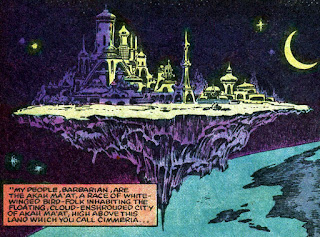If setting books for rpgs sometimes get a bad rap, history sections of setting books are probably even more widely reviled. There are reasons for this, but I don't think the solution is that history should be banned from rpg books entirely. I do think it's worth thinking about why we have history (particularly deep history) in rpg setting books, when it's useful and maybe when it isn't.
My thesis is that history in rpg books is most useful/good when it does something. Possible somethings are:
1. Helps to orient the reader (mostly the GM) to the themes/mood/flavor of the setting.
2. Directly establishes parameters that impact the player's adventures.
3. Provides "toys" or obstacles.
It is unhelpful when it does the following:
1. Describes events that have little to no impact on the present.
2. Describes events which are repetitive in nature or easy to confuse.
3. Provides few "toys," or ones that are not unique/distinctive.
Now, I am not talking specifically here about number of words or page counts, which I think a lot of people might feel is the main offender. Those are sort of dependent on the style/marketing position of the publication. Bona fide rpg company books tend to be written more densely and presumably read more straight for pleasure. DIY works are linear and more practical. My biases are toward the latter, but I am more concerned with content here. I do think
in general that economy of words makes good things better, and verbosity exacerbates the bad things.
Let's get into an example from
Jack Shear's
Krevborna:
Gods were once reverenced throughout Krevborna, but in ages
past they withdrew their influence from the world. Some say that
the gods abandoned mankind to its dark fate due to unforgivable
sins. Others believe that the gods retreated after they were
betrayed by the rebellious angels who became demons and
devils. Some even claim that the gods were killed and consumed
by cosmic forces of darkness known as the Elder Evils.
Looking at my list of "good things" it hits most of them. It helps orient to mood and theme (lack of gods, dark fate, unforgivable sins), it sets parameters for the adventurers (cosmic forces of darkness, no gods), and provides obstacles (demons and devils, rebellious angels, elder evils).
That's pretty brief, though. What about a wordier example? Indulge me in an example from my own stuff:
So, the good stuff: orienting to theme, mood. etc. (deep history, memeplexes, super-science, transcendence as old hat, names suggesting a multicultural melange), setting parameters (a fallen age compared to the past, psychic powers, vast distances), and toys and obstacles (psybernetics and a host of other advance tech, Zurr masks, Faceless Ones!)
But wait, have I done one of the "bad things?" I've got two fallen previous civilizations? Isn't that repetitive and potentially confusing? I would say no. The Archaic Oikueme is the distant past (it's in the name!). It's the "a wizard did it" answer for any weird stuff the GM wishes to throw in, and the source of McGuffins aplenty. The Radiant Polity is the recent past. Its collapse is still reverberating. It is the shining example (again, in the name) that would-be civilizer (and tyrants) namecheck.






































